Janet Fox's Blog, page 30
January 24, 2013
Reviving the Ailing Manuscript: When Is It Time to Let Go?
All writers have them: manuscripts in various stages of completion that may or may not ever see the light of day. I'm not talking about work that we've abandoned because life got in the way; I'm talking about work that just doesn't feel right.
I have a few of these books and I stare at the files and ask myself, what went wrong? And, can it be fixed?
Recently Marion Dane Bauer spoke to this topic in a series of excellent blog posts addressing her own failed picture book manuscript. She rightly states that picture books are such fragile things that it's nigh on impossible to resuscitate a failed picture book. But, she adds, it might be easier to bring a failed or failing novel back to life.

That notion pushed me to examine some of the reasons my own novels have "failed" or are failing, and whether I might be able to give them a second chance. Here are some of my observations in case they are useful to you:
If the reason for failure is due to weak characterization of protagonist or antagonist:
This may be resolvable. A deeper character analysis might reveal a backstory wound. A change in tone might bring a character's voice to light. A shift in point of view - from, say, third to first person - can often shift the character into gear. Taking the character outside her comfort zone - stressing her, putting her in harm's way - can often reveal the underpinnings of response. Forcing the character into doing something "out of character" can elicit deeper revelations and emotional reactions.
If this is my problem, and I still love the story, I'll give it a second chance.
If the reason for failure is due to weaknesses in the plot:
This one is tougher for me and often depends upon where I am in the novel - first draft, second draft, etc. Do I have enough tension? Can I add or subtract scenes to increase the tension or reveal new things about my characters or the situation? Can I spin the plot in a new direction without trashing the story entirely?
But in that last question lies the difficulty. If my premise is weak, I'm in trouble. Or, rather my novel is in trouble. It's hard to shore up a weak premise. Sometimes I can spin the premise, turn it around and look at it from another direction; but sometimes...
And in the case of writing fantasy or science fiction (both of which I'm trying now), the premise is everything, in my view. And if the premise, however good, has been done to death in recent years (vampires, anyone?) then the novel will likely be viewed as derivative at best. Time to abandon. If the premise is unwieldy such that your reader cannot suspend disbelief, time to abandon, or at least set aside.
If the reason for failure is due to lack of heart:
Fatal. If I have lost the heart of my story - the love for the story above anything else, a belief in the power of that story, a feeling that it reveals my own heart and the underpinnings of the human experience - I'm done.
Here's what Marion had to say, and she's right: the deepest flaw that can inhabit any piece is a lack of genuine heart. I have to love the story to pieces to be able to write it. And I know that an editor, agent, and my readers will feel my lack of heart and respond with a "meh" if I don't give them my emotional all. (This is why I don't write assignment work, unless the assignment speaks to me.)
We've all read books by authors we love that seem to be weak, or lost altogether; I imagine it's hard for an editor to put aside the work of a successful author. I would rather be my own arbiter of what I want to send out into the world. I have maybe half a dozen completed but flawed novels that will likely never see the light of day, that I've set aside, even when someone has asked for the work.
But that's fine. I move on and write the next one, and the next and the next. As Marion says, the very act of writing feeds us...Success is only a happy byproduct, not the reason for our effort.
Exactly.
I have a few of these books and I stare at the files and ask myself, what went wrong? And, can it be fixed?
Recently Marion Dane Bauer spoke to this topic in a series of excellent blog posts addressing her own failed picture book manuscript. She rightly states that picture books are such fragile things that it's nigh on impossible to resuscitate a failed picture book. But, she adds, it might be easier to bring a failed or failing novel back to life.

That notion pushed me to examine some of the reasons my own novels have "failed" or are failing, and whether I might be able to give them a second chance. Here are some of my observations in case they are useful to you:
If the reason for failure is due to weak characterization of protagonist or antagonist:
This may be resolvable. A deeper character analysis might reveal a backstory wound. A change in tone might bring a character's voice to light. A shift in point of view - from, say, third to first person - can often shift the character into gear. Taking the character outside her comfort zone - stressing her, putting her in harm's way - can often reveal the underpinnings of response. Forcing the character into doing something "out of character" can elicit deeper revelations and emotional reactions.
If this is my problem, and I still love the story, I'll give it a second chance.
If the reason for failure is due to weaknesses in the plot:
This one is tougher for me and often depends upon where I am in the novel - first draft, second draft, etc. Do I have enough tension? Can I add or subtract scenes to increase the tension or reveal new things about my characters or the situation? Can I spin the plot in a new direction without trashing the story entirely?
But in that last question lies the difficulty. If my premise is weak, I'm in trouble. Or, rather my novel is in trouble. It's hard to shore up a weak premise. Sometimes I can spin the premise, turn it around and look at it from another direction; but sometimes...
And in the case of writing fantasy or science fiction (both of which I'm trying now), the premise is everything, in my view. And if the premise, however good, has been done to death in recent years (vampires, anyone?) then the novel will likely be viewed as derivative at best. Time to abandon. If the premise is unwieldy such that your reader cannot suspend disbelief, time to abandon, or at least set aside.
If the reason for failure is due to lack of heart:
Fatal. If I have lost the heart of my story - the love for the story above anything else, a belief in the power of that story, a feeling that it reveals my own heart and the underpinnings of the human experience - I'm done.
Here's what Marion had to say, and she's right: the deepest flaw that can inhabit any piece is a lack of genuine heart. I have to love the story to pieces to be able to write it. And I know that an editor, agent, and my readers will feel my lack of heart and respond with a "meh" if I don't give them my emotional all. (This is why I don't write assignment work, unless the assignment speaks to me.)
We've all read books by authors we love that seem to be weak, or lost altogether; I imagine it's hard for an editor to put aside the work of a successful author. I would rather be my own arbiter of what I want to send out into the world. I have maybe half a dozen completed but flawed novels that will likely never see the light of day, that I've set aside, even when someone has asked for the work.
But that's fine. I move on and write the next one, and the next and the next. As Marion says, the very act of writing feeds us...Success is only a happy byproduct, not the reason for our effort.
Exactly.
Published on January 24, 2013 09:18
January 14, 2013
Footsteps: Revision
A few weeks back I gave out some practical revision ideas, but today I want to examine a more nuanced way to look at revision.
 My walk in the summer and fall.Every day I try to take a walk. Usually I’m taking the same walk, retracing my footsteps. It’s a good walk, part exercise, part meditation; I use my walking time to let my brain ruminate on my current project, and more often than not, that rumination is fruitful.
My walk in the summer and fall.Every day I try to take a walk. Usually I’m taking the same walk, retracing my footsteps. It’s a good walk, part exercise, part meditation; I use my walking time to let my brain ruminate on my current project, and more often than not, that rumination is fruitful.In fact I find that I reach a breakthrough idea at about the same point every walk - that must be the place where my brain relaxes into my physical exertion and my internal editor goes on vacation, because I come up with my best ideas as I reach that rock, that tree.
Today, while walking this route, I could see the imprint of yesterday’s walk in the fresh snow. I put my foot in the same imprint at times; at times, I moved away for easier footing or a more direct route. Sometimes I moved even further, if I heard or saw something of interest that I could incorporate into my walk, weaving a deer sighting or a wolf track into the thread of this walk and into memory.
 Winter dawn at my new Bozeman house...just because.This is how I see revision. I walk in the footsteps of my previous work. Sometimes I work to make something more direct. Sometimes I clarify. And sometimes I find an entirely new thread, a new path, or a new and exciting interest.
Winter dawn at my new Bozeman house...just because.This is how I see revision. I walk in the footsteps of my previous work. Sometimes I work to make something more direct. Sometimes I clarify. And sometimes I find an entirely new thread, a new path, or a new and exciting interest.I love revising, almost as much as I love walking. The generation of work is exciting, just as walking a new route can be a thrill. But walking the same route every day is a pleasure of a different kind – awakening my senses and sharpening my focus.
So I’m off to revise...right after my walk!
Published on January 14, 2013 18:50
January 7, 2013
Upcoming Texas Tour
While I'm still digging myself out of boxes (too many books! Can someone have too many books? Yes, when that someone has to move them into a new home...) I thought I'd post information about my upcoming Texas book tour. I'm excited to get back to my for-awhile home state and see many great friends, so here's the itinerary.
Tuesday, January 29th
7 pm
BookPeople
603 N. Lamar Blvd.
Austin, TX 78703-5413
512-472-4288
Wednesday, January 30th 6:30 pm
Westbank Library
1309 Westbank Drive
Austin, TX 78746
512-327-3045
Thursday, January 31st Guest room at The Writing Barn 12-2 pm
Guest room at The Writing Barn 12-2 pm
Discussion / librarian book exchange
Austin Public Library
While in Austin, I'll be staying at The Writing Barn. I'm going to write a blog post about that experience when I return.
Friday, February 1 - Sunday, February 3Montgomery County Book Festival
The MCBF should be an awesome weekend event, with many terrific authors in attendance. I'm thrilled to be involved. Panels will run all day Saturday, with time for attendees to meet their favorite authors.
Tuesday, February 56 PM B&N College Station
Lone-Star Pavilion
711 Texas Avenue
College Station, TX 77840
979-764-8955
Houston's Joy Preble (the Anastasia series) will join me for a booktalk in College Station.
I hope I get to see you in Texas!
Tuesday, January 29th
7 pm
BookPeople
603 N. Lamar Blvd.
Austin, TX 78703-5413
512-472-4288
Wednesday, January 30th 6:30 pm
Westbank Library
1309 Westbank Drive
Austin, TX 78746
512-327-3045
Thursday, January 31st
 Guest room at The Writing Barn 12-2 pm
Guest room at The Writing Barn 12-2 pmDiscussion / librarian book exchange
Austin Public Library
While in Austin, I'll be staying at The Writing Barn. I'm going to write a blog post about that experience when I return.
Friday, February 1 - Sunday, February 3Montgomery County Book Festival
The MCBF should be an awesome weekend event, with many terrific authors in attendance. I'm thrilled to be involved. Panels will run all day Saturday, with time for attendees to meet their favorite authors.
Tuesday, February 56 PM B&N College Station
Lone-Star Pavilion
711 Texas Avenue
College Station, TX 77840
979-764-8955
Houston's Joy Preble (the Anastasia series) will join me for a booktalk in College Station.
I hope I get to see you in Texas!
Published on January 07, 2013 13:11
December 23, 2012
Happiest of Holidays
I'm going on a short hiatus while we move into our new home (yay!) in Bozeman, Montana, and I squeeze in time to finish pages on a middle grade novel. I'll be back the first week in January with a final revision post and some new things to bring to everyone.
So, the happiest of holidays and warmest wishes of this blessed season to you all. Just for fun, here's a look at our new living room only a couple of weeks ago - now it's filled with boxes. Presents under the "tree!"

So, the happiest of holidays and warmest wishes of this blessed season to you all. Just for fun, here's a look at our new living room only a couple of weeks ago - now it's filled with boxes. Presents under the "tree!"

Published on December 23, 2012 20:21
December 16, 2012
Purely Personal: On Taking a Stand
I love writing for children. I’ve often thought that it’s because I’m reliving something from my childhood. But I also see that it’s because children ask the most direct questions, some of which I cannot answer. I’m trying to answer them for the children who read my books and for the child inside me.
So my question, right now, in the wake of Sandy Hook, is: why?
Why are we here? Why do innocent children die? Why do we suffer? Why does discourse lose civility, and why can we not find common ground?
I write for children hoping to find an answer to these questions.
I’m deeply proud to be a member of the kidlit community that asks and seeks to answer these questions. This is a passionately committed community that strives to protect children, to engage children, to help children find answers to the fundamental questions, and especially to the central question: why?
I don’t have answers, but I do have thoughts. And one of these thoughts is that if I can’t answer the questions, I can do something.
 I can take a stand.
I can take a stand.There is no more time in our society to look away. Too many children suffer. We can no longer look away from child exploitation. We can no longer look away from child slavery and forced child marriage. We can no longer look away from the violence promulgated by the entertainment industry aimed at children. We can no longer look away from the ease of access to weapons that kill the most innocent with impunity.
I can no longer look away.
I am taking a public stand against access to assault weapons.
I believe there is no earthly or God-given reason that a semi-automatic weapon capable of killing scores of people – of killing twenty innocent children – even when wielded by an inexperienced shooter should be available to any person, at any time.
I’m taking a stand in favor of gun control.
I’m also taking a stand in favor of hope.
This is the time of year when we all look to the most generous of human ideas: that birth is a gift and yet that our life may require sacrifice, self-denial, and loss. Human generosity – that the gift of life does require sometimes overwhelming sacrifice – gives me hope.
A teacher who barricades a door and loses her life in the bargain has sacrificed everything for her children, and this gives me deep grief, but also hope. A first responder who carries the unimaginable burden of doing a job well in the face of personal horror gives me hope. A nation that takes stock and may be awakening to a new reality gives me hope.
Why are we here? What is the meaning of life?
More importantly, why are you here? What kind of stand can you take – can we take – that will make a difference to the children today and the children of the future?
This is an important question, and I’m asking myself this question every hour. And I’m taking a stand. I’m standing up for the children.
I hope you'll stand with me.
Published on December 16, 2012 19:46
December 11, 2012
Jingle Bell Hop! Blog Hop Post
I was tapped by my friend Jan Godown Annino to participate in a blog hop. In case you don’t know Jan’s work, she’s the author of an acclaimed picture book biography, SHE SANG PROMISE, illustrated by Lisa Desimini. It would be a wonderful addition to any library.
I’m answering here the questions that she passed along to me. And I thought I’d talk about one of my WIPs. I usually keep this stuff to myself until the very end, so as not to jinx anything. Fingers crossed!
What is the working title of your book?
THE NETHERWORLD.
Where did the idea come from for the book?
I had a dream that I was suspended in a place between life and death, and when I woke up, I knew I had to write about how that felt. This novel is a bit dark and dreamlike.
What genre is your book?
Middle grade fantasy.
 What is the synopsis of the novel?
What is the synopsis of the novel?Jake, a boy who is trying to deal with a school bully, causes an accident that renders his sister Eliza unconscious and near death. Jake is told that if he sells his soul he can rescue her from the Netherworld, the place between life and death. He agrees; but his mission is not as simple as it would seem. By entering the Netherworld Jake sets in motion other and bigger events. Jake and Eliza and the Netherworld guardian Mab must find a way to save Eliza, Jake’s soul, and the Netherworld itself.
How long did it take to write the first draft?
I’ve got a very rough first draft that took me about four months to write. But most of that draft will disappear...I started the novel as a workshop piece at Vermont College of Fine Arts and it grew.
What other books are comparable to this book?
Middle grade fantasy is booming and rich at the moment - something that excites me greatly. I’m reading THE PECULIAR by Stefan Bachmann, and just finished GOBLIN SECRETS by William Alexander, and I think they both have things in common with THE NETHERWORLD. And I love Lauren Oliver’s fantasies – especially LIESL AND PO.
I’ve tagged my friends and fabulous authors Bethany Hegedus and Joy Preble, so please check their blogs in the next couple of weeks for their blog hop posts!
Bethany's link: http://www.thewritingbarn.com/category/blog/
Joy's link: http://joysnovelidea.blogspot.com/
Published on December 11, 2012 08:04
December 3, 2012
Revision, Part 2
Last week I talked about a few of the more global approaches that I take while revising a manuscript in progress; this week I’ll try and finish up with the following:
how I use checklistsmy favorite workbooksdedicated passes
As I move into the middle to later stages of revision, I like to use checklists to remind me to pay attention to my own personal quirks – the tics I’ve developed as a writer that weaken my writing. Because my first drafts are so organic, I tend to be lazy at times – I’m paying more attention to getting stuff down on paper than I am on the smaller issues. So this mid-revision process is truly important.
Here’s a personal checklist that I developed a long time ago:Find all the "ly" words (i.e., adverbs) by using the Word "find" feature and eliminating most - if not all.Search for "it is/was" and "there is/was". It's almost always stronger to use different phrasing. (Or, by example... “Phrases are almost always stronger when they don’t begin with ‘it's’.”)Search for places where my character "felt," "saw," "looked," etc. When I'm really inside my character, those soft verbs aren't necessary. Much better to show the event or action without the distancing verbs.Search for sentence "flow." In particular, I look sentence by sentence for stronger first and last words. First and last are the most important words in the sentence.Search for passive voice and other indicators of "telling" (like, helping verbs, "to be" verbs).Try to make sure there's tension on every page. Remove dialogue tags wherever possible. Even "said" can get in the way when only two people are talking.Make sure gesture substitutes for internal thoughts wherever possible.Look for those things that popped up in my subconscious and may be amplified - recurring metaphors or images.
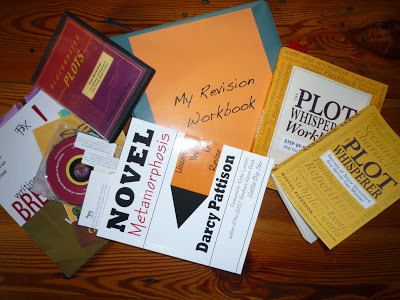 my own workbook in the company of the "greats"Watch for unintentional repetition of certain words and phrases.
my own workbook in the company of the "greats"Watch for unintentional repetition of certain words and phrases. I have several workbooks that are particular favorites, and at some stage of revision I’ll work through some or all of the exercises within:DonaldMaass, Writing the Breakout Novel Workbook DarcyPattison, Novel MetamorphosisMarthaAlderson, The Plot Whisperer WorkbookCherylKlein, Second Sight
As you can see, I’ve made up my own workbook that includes my checklists and some others I’ve collected at conferences and workshops. In that workbook is a list of the things I look for in my dedicated passes.
At some point near the end of the revision process, I’ll do a dedicated pass for things like:smooth and interesting transitions between chaptersmagnification of character traitsitems of metaphoric significance or resonant setting details or thematic elements that can be amplified
These dedicated passes allow me to focus on just one thing at a time. Sometimes, in a more complicated story, I may have to do a dedicated pass for small items like eye or hair color, or prop details.
What this all means is that I often do 15 or 20 or more revisions for each work. Sometimes things change radically from revision to revision; sometimes I'm changing just one thing, albeit important (to me, at least.) The later revisions usually take only a short amount of time - maybe only a day each. But this process works for me.
Next week I’ll be participating in a blog hop – but the following week I’ll talk about the most important aspect of revision: inspiration.
Published on December 03, 2012 14:07
November 26, 2012
Revision! Tools and Techniques
Now that NaNoWriMo is almost over, it’s time for the next step in the process...revision!
Some of you might think that revision is a dirty word. It’s not fun to go over and over something – especially if there seems to be no end in sight.
But I actually prefer revision to writing the first draft. I often don’t plumb my character’s depths until about draft 3; and the plot is pretty messy until draft 6 or 7; and it isn’t until the umpteenth draft that I can play with fun things like language and theme and tone and detail.
In a couple of weeks I’ll talk about holding fast to your initial vision, as you “re-envision” your manuscript, but this week and next I thought I’d share some of the things I do when I revise and some of the tools I find most helpful.
There are 5 specific tools that I use when I revise:
1. taking stock of the “big picture”2. visual aids (charts, photos, graphs)3. checklists4. workbooks5. dedicated passes
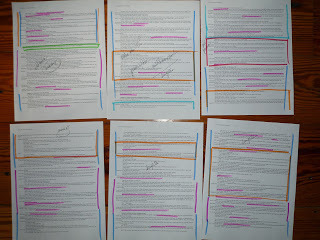 one of my shrunken manuscriptsHere are the first two of these tools as I use them:
one of my shrunken manuscriptsHere are the first two of these tools as I use them:1. Taking stock of the “big picture”
The first thing I do when I’ve finished what I consider the initial draft is put it aside. Not for too long – I need the story’s momentum to keep moving forward – but I give it a few days rest, letting it marinate, and I do something completely different (like eat chocolate...)
After those few days I pick up the manuscript again and read it through, cover to cover. In this process I try to read aloud – there’s something about reading words out loud that allows me to find things that don’t work or sound awkward. (Yes, I get pretty hoarse.) I also try not to stop in the middle and change something huge – I’ll make notes in the margins as I go, but I want to get a feel for the entire scope of the story.
My favorite big picture technique is Darcy Pattison’s “shrunken manuscript”, which allows me to visualize the story at a very large scale. I highly recommend that you find a copy of Darcy’s Novel Metamorphosis , as it contains several similar techniques and one of the others might strike your fancy. But here’s the gist of the shrunken manuscript:Shrink your manuscript to 8 point font, single spacing, with no chapter breaks - you'll be able to read it, just enough to know where you areHighlight areas for different aspects of the manuscript – character development, description, subplots, moments of tension (or lack thereof), etc., etc.Stand back and just look
You’ll see from that distance where you may be missing details of character that are crucial, where your subplots flag or disappear, where you’ve dropped the tension, and so on. This is a great way to discover if your manuscript is too description-heavy, or too action-oriented, or where you may have lost track of a character (as I did while writing my first novel, Faithful, and a main character at that!)
 my plot board with notes and Martha Alderson plotline
2. Visual aids
my plot board with notes and Martha Alderson plotline
2. Visual aids
I’m a visual person, and at some point in crafting a story the only way I can see whether I’ve developed it properly is to see it visually – usually on the wall of my office, where I can spread out the timelines and plotlines together with notes and photographs.
A tool I’ve recently become fond of is Pinterest, and I’ve created boards for each of my novels, allowing me not only to see the pictures that are inspirational to me but also to share those with readers as they develop.
 plot planner in miniatureBy far my favorite visual aid is Martha Alderson’s
PlotWhisperer
plotline (do check out her Plot Whisperer books and other tools.) I’ve made a corkboard with the plotline marked in masking tape, and from there I can use sticky notes to jot down scenes, emotional changes, conflict. Small sticky notes are perfect because I can’t write too much – just enough to direct my thoughts. Plus, I can work in color for different aspects of the story and that appeals to my visual sense.
plot planner in miniatureBy far my favorite visual aid is Martha Alderson’s
PlotWhisperer
plotline (do check out her Plot Whisperer books and other tools.) I’ve made a corkboard with the plotline marked in masking tape, and from there I can use sticky notes to jot down scenes, emotional changes, conflict. Small sticky notes are perfect because I can’t write too much – just enough to direct my thoughts. Plus, I can work in color for different aspects of the story and that appeals to my visual sense.On that board I also post head shots of my characters, and eventually I’ll post a miniature version of Martha’s plotline, one that I’ve integrated with the hero’s journey and other turning points.
Next week I’ll talk about the other revision tools I find helpful – but please share yours here, too!
Published on November 26, 2012 15:11
November 15, 2012
Reading Like a Writer: Maggie Stiefvater’s THE SCORPIO RACES and Magical Realism
Magical realism is a phrase I never completely understood until I recently read Maggie Stiefvater’s The Scorpio Races . The term seems contradictory: how could a realistic story contain magical elements? What does a writer do to introduce those elements without throwing the novel into the terrain of fantasy? I suppose some readers will argue that The Scorpio Races is fantasy, but I’m going to take the side of magical realism, and this analysis approaches her fabulous story with that in mind.
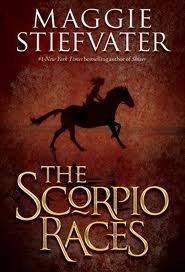 Her setting is entirely believable – an island off the coast of, well, something like Ireland. There are references to the mainland, the Atlantic, and America, and the names she uses have that Celtic ring: Finn Connolly, Sean Kendrick, Skarmouth, Thisby. Our heroine’s nickname is Puck, conjuring Shakespeare. People live in proper houses, drink in pubs, drive Morris cars, raise sheep; the rock-strewn grass hillocks are contained by hedgerows and stone walls. Altogether this is a place we know, its familiarity bred of our familiarity with Anglo-Saxon literature and lore, even if there is one extremely odd thing about this place.
Her setting is entirely believable – an island off the coast of, well, something like Ireland. There are references to the mainland, the Atlantic, and America, and the names she uses have that Celtic ring: Finn Connolly, Sean Kendrick, Skarmouth, Thisby. Our heroine’s nickname is Puck, conjuring Shakespeare. People live in proper houses, drink in pubs, drive Morris cars, raise sheep; the rock-strewn grass hillocks are contained by hedgerows and stone walls. Altogether this is a place we know, its familiarity bred of our familiarity with Anglo-Saxon literature and lore, even if there is one extremely odd thing about this place.The sea that surrounds the island is inhabited by flesh-eating water horses.
By the time I was ten pages in, I completely believed that Thisbe exists, and that I’d better watch out for those frightening yet beautiful uisce. That this magical element of The Scorpio Races also derives from our Celtic heritage is part of what makes it feel real.
The deadly November races on the backs of the uisce forms the heart of the concept, but this is also a love story, a coming-of-age story, a love-of-horse story, and a triumph of the spirit over soulless financial power. Sean and Puck tell their tales in first person present tense, enhancing the immediacy of both characters and plot: “this is happening to me, and it’s happening right now.” Once we buy into these characters, we buy the whole tale, hook, line, and sinker.
Puck is a game girl with a face full of freckles and unruly hair in the middle of an unruly orphaned life:
For a moment, I see the room like anyone else might see it. It looks like everything around Finn has crawled out of the mouth of the kitchen sink drain. It’s a mess, and we’re a mess, and no wonder Gabe wants to leave.‘Let’s go,’ I say.
Sean’s voice is hard, born of his hard luck, and he knows horses. He knows horses better than anyone. He’s also a boy of few and well-chosen words:
I slide off her and hand him the reins. He takes them with a puzzled expression on his already puzzling face.I say, ‘This mare is going to kill someone.’
The strong and enticing Puck and Sean, who are (as the reader sees long before they do) a perfect match, are also so much fun to live with that the story’s magical element is almost unnecessary. As a writer then, I've come to think that the best magical realism must possess this quality: that the realistic aspects of the story are even more engaging than the magical aspects.
In a true fantasy, our perception of the story itself may be clouded by dwarf behavior, elf antics, or fairy godmother wishes. In magical realism, the author could dispense with the magic – and still have a heck of a great tale. Of course, it doesn’t hurt that Stiefvater writes beautifully, conjures a complete and visible world, and that her secondary characters are every bit as engaging as her protagonists.
But I maintain that in order to write great magical realism it is necessary to write a great, rich and complex story that rises above the magic – that the realistic part of the story makes a magic all its own.
My donation drive for the American Red Cross continues all month, including comments on this blog post. Many thanks!!
Published on November 15, 2012 15:23
November 5, 2012
SIRENS Launch Week, Plus
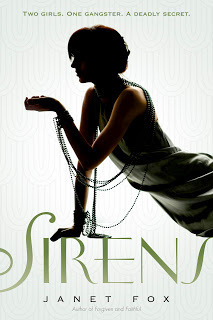 It's SIRENS launch week and I'm very excited to share my latest work with you.
(As a reminder - during the entire month of November, every comment on every post on the Wardrobe elicits a donation to the American Red Cross. Plus you might win a copy of SIRENS! See this post for details.)
It's SIRENS launch week and I'm very excited to share my latest work with you.
(As a reminder - during the entire month of November, every comment on every post on the Wardrobe elicits a donation to the American Red Cross. Plus you might win a copy of SIRENS! See this post for details.)
Now to the business at hand: my launch post! (I'm excited. Did I mention that?)
One of the most evocative scenes in American fiction takes place in a living room in a Long Island mansion and features two girls, Daisy and Jordan, long-limbed and lounging, dressed in white. The scene is in F. Scott Fitzgerald’s THE GREAT GATSBY, set in 1925, the year of its publication. Although not historical fiction in the strictest sense, it is fine fiction in the best sense – and it brings to life the Roaring Twenties in America. Great historical fiction brings the past to life. I can't wait for the movie version due out this summer.
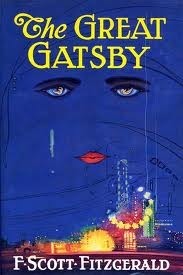 I couldn’t be happier that the 20s are experiencing, forgive the pun, a renaissance. Anna Godberson has released the BRIGHT YOUNG THINGS series, and Jillian Larkin has crafted THE FLAPPERS series; Libba Bray has launched THE DIVINERS.
I couldn’t be happier that the 20s are experiencing, forgive the pun, a renaissance. Anna Godberson has released the BRIGHT YOUNG THINGS series, and Jillian Larkin has crafted THE FLAPPERS series; Libba Bray has launched THE DIVINERS.I'm thrilled to have SIRENS join the mix.
When I did my research I was all prepared for flappers and bootleggers, for gangsters (Al Capone) and gorgeous skimpy clothes (Coco Chanel.) Women got the vote, and writers had the Round Table. The 1920s in America was a wild and crazy time of financial boom and liberated behavior, a period when a fluid and mobile society, combined with the freedom afforded by the automobile and the new working middle class, allowed teens to flee from their parents’ Victorian restrictions. Advertising - the "Mad Men" era - was born, in fact, in the '20s.
Yes, everybody was on board with dancing and drinking (albeit not legally) and public necking. The 1920s in America were Party Time Central.
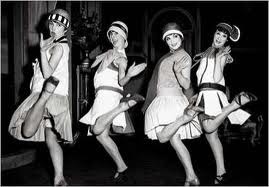 But the 1920s was also a time of quiet civil unrest and spiritual exploration. The Ku Klux Klan experienced a rebirth, with open marches and anti-black, anti-immigrant posturing. Immigrants of Italian, Irish, and Jewish extraction were pitted against one another and against society in general. A bomb went off on Wall Street in September 1920, targeting the rich capitalists of the stock exchange but killing clerks, runners and stenographers; it was said to be the work of radical Bolshevists, although no clear culprit was ever found.
But the 1920s was also a time of quiet civil unrest and spiritual exploration. The Ku Klux Klan experienced a rebirth, with open marches and anti-black, anti-immigrant posturing. Immigrants of Italian, Irish, and Jewish extraction were pitted against one another and against society in general. A bomb went off on Wall Street in September 1920, targeting the rich capitalists of the stock exchange but killing clerks, runners and stenographers; it was said to be the work of radical Bolshevists, although no clear culprit was ever found. 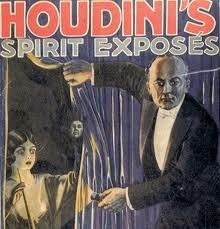 Sir Arthur Conan Doyle engaged in a long-running verbal war with his friend Harry Houdini over the question of spiritualism. Houdini was a pragmatist; he knew magic to be a performance. Doyle believed in spirits and the afterlife, and participated in a movement that experienced a resurgence in the 20s.
Sir Arthur Conan Doyle engaged in a long-running verbal war with his friend Harry Houdini over the question of spiritualism. Houdini was a pragmatist; he knew magic to be a performance. Doyle believed in spirits and the afterlife, and participated in a movement that experienced a resurgence in the 20s.The parallels between today and the 1920s-1930s are all too evident: the prosperity of the Roaring Twenties echoed in the 1990s boom; the market crash of 1929 and 1930s depression echoed in the 2000s bust. Post-war trauma today found expression first after World War 1; we fear global pandemic today, but the deadly flu pandemic of 1918 killed millions.
Today we recognize the parallels of our own lives with the past, and maybe make sense of the present. I hope that I added to the "making sense" part of it with SIRENS.
Here's the full trailer for SIRENS, thanks to my talented son Kevin:
Published on November 05, 2012 19:58



